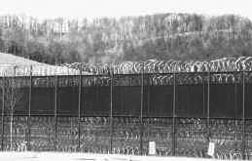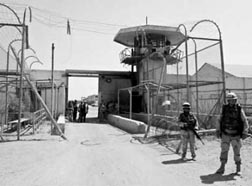
May 2004
|
From SCI Greene to Abu Ghraib
Torturer Is Guard At Prison Where Mumia Abu-Jamal Held
 Top: SCI Greene
prison in western Pennsylvania.
Top: SCI Greene
prison in western Pennsylvania. Middle: Abu Ghraib prison outside Baghdad. MAY 6 – Today it was revealed
that one of the main torturers at the Iraqi prison of Abu Ghraib, Spec. Charles
Graner, is a reservist who works as a guard at the State Correctional Institution Greene in southwestern Pennsylvania,
the high security prison where death row political prisoner and renowned black
radical writer Mumia Abu-Jamal has been jailed for decades. The grinning Graner
of the Iraq torture photos was in the Marines from 1988 to 1996. He
turns out to be a sociopath who In the spring of 1998, two to three dozen inmates of the “restricted housing unit” (known as “the Hole”) where the abuse was centered, including Jamal, went on hunger strike over the confiscation of their legal papers by prison authorities. This drew attention to the widespread brutalization of prisoners there, including “guards beating prisoners and then writing KKK (i.e. Ku Klux Klan) with the inmates’ blood; the ‘working over’ (beating) of certain prisoners by guards upon the instruction of superior officers to ‘adjust their attitudes’; and guards spitting tobacco juice into inmates’ food” (Amnesty International, “USA: A Life In The Balance – The Case of Mumia Abu-Jamal,” February 2000). To avert the glare of media attention, four guards were fired and another 21 were demoted, suspended or reprimanded. But the system is intact, and now it is being reproduced in Iraq. It is necessary to mobilize workers’ power to free Mumia Abu-Jamal, and to demand freedom for the tens of thousands imprisoned in U.S. imperialism’s Iraqi and Afghan concentration camps, the hundreds of inmates of the Guantánamo prison camp, and the unknown numbers still being detained in the United States. |
30 April 2004
(Excerpted)
Forced to stand on a box with wires attached to your fingers, toes and penis all night long. Just something that Specialist Sabrina Harman dreamed up in Abu Ghraib prison? Think again.
This torture is well known to intelligence agencies worldwide. The CIA documented the effects of forced standing forty years ago. And the technique is valued because it leaves few marks, and so nothing to document.
Forced standing was a prescribed field punishment in West European armies in the early 20th century. The British Army called it Field Punishment No 1, though the soldiers referred to it as “the crucifixion.” The French Legionaires called it “the Silo.”
By the 1920s, forced standing was a routine police torture in America. In 1931, the National Commission on Lawless Enforcement of the Law found numerous American police departments using forced standing to coerce confessions.
In the 1930s, Stalin's NKVD also famously used forced standing to coerce seemingly voluntary confessions for show trials. The Gestapo used forced standing as a routine punishment in many concentration camps. It even created small narrow “standing cells,” Stehzelle, where prisoners had to stand all night.
In 1956, the CIA commissioned two experts, Wolf and Hinkle, who described the effects of forced standing. The ankles and feet swell to twice their size within 24 hours. Moving becomes agony. Large blisters develop. The heart rate increases, and some faint. The kidneys eventually shut down.
In the mid-20th century, torturers learned how to use the swelling and blistering to cause more pain. The South Africa and Brazilian police made prisoners stand on cans or bricks, the edges causing excruciating pain to the sensitive feet. In 1999, the South African Truth Commission determined that forced standing was the third most common torture during Apartheid after beating and electricity.
Hooding was a common feature of Brazilian and South African torture. In the 1970s, the Brazilians added the electrical supplement. When the hooded man on the can was electrified, the cans stuck to his feet even when he keeled over.
The American soldiers performed the torture, but someone taught them the parameters. This kind of torture is not common knowledge, and if it were not for the photographs, no one would know that it had been practiced.
Today American interrogators are using “stress and duress” techniques in prisons in Afghanistan and Diego Garcia. Officials refer to these techniques as “torture lite.” Abu Ghraib gave us the first chance to see what these techniques really are: stealth tortures that leave no marks.
Torture like this doesn't just happen “over there.” Torture like this casts a shadow back here for years afterwards. Soldiers trained in stealth torture take these techniques back into civilian life as policemen and private security. It takes years to uncover the subsequent damage. The American style in electric torture in Vietnam appeared in Arkansas prisons in the 1960s and Chicago squad rooms in the 1970s and 1980s.
Darius Rejali is a nationally recognized expert on torture and interrogation, the author of Torture and Democracy (forthcoming Princeton) and a 2003 Carnegie Scholar. He is an Associate Professor of Political Science at Reed College.
To contact the Internationalist Group and the League for the Fourth International, send e-mail to: internationalistgroup@msn.com
 brutalized and threatened his wife. But more important than this warped individual
are the conditions which shaped him. SCI Greene is notorious for the racist
abuse routinely dispensed by guards like Graner. In 1998, there was an uproar
over abuse of prisoners, who complained that guards “prison routinely beat
and humili ated prisoners,
including through a sadistic game of Simon Says in which guards struck prisoners
who failed to comply with barked instructions” (New York Times, 6
May).
brutalized and threatened his wife. But more important than this warped individual
are the conditions which shaped him. SCI Greene is notorious for the racist
abuse routinely dispensed by guards like Graner. In 1998, there was an uproar
over abuse of prisoners, who complained that guards “prison routinely beat
and humili ated prisoners,
including through a sadistic game of Simon Says in which guards struck prisoners
who failed to comply with barked instructions” (New York Times, 6
May).